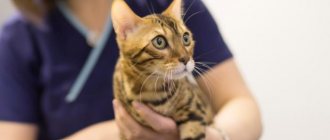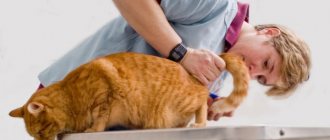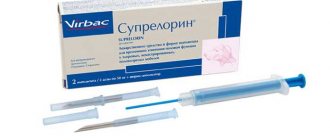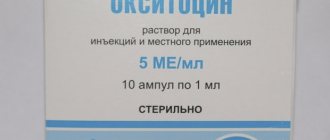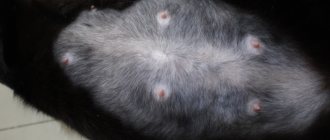Surgical manipulation - caesarean section, is performed in cats and dogs when problems arise during the birth process. As a rule, the main indication for surgical intervention is the inability to give birth physiologically. There may be planned operations, but most often emergency surgery is performed.
If the cat is not kept by the owner for breeding, veterinary experts recommend sterilization during cesarean section, which will avoid diseases in the reproductive sphere or minimize the risks of their occurrence.
Obstetrics – Forum about cats for cat lovers and felinologists
The Scottish cattery PRIDE OF SCOTLAND has completed a litter of four kittens. Kittens are available for purchase.
If everything goes as usual, without delays in the contractions and in the advancement of the fetus for more than 5 minutes, just help her with your hands: stroke her, slightly rest your hand on the sternum and ribs - to help push and expel the fetus. If there are no contractions, but the water has broken, or the contractions have suddenly weakened, and the fetus has already appeared, inject oxytocin into the muscle - no more than 1/10 of the ampoule. (Remember - alcohol destroys oxytocin, so when cleaning the needle before the next injection, let it dry). I read this here: https://www. kitty ru/Rody/Borning. htm
Oxytocin. This drug is injected during weak labor. It causes contractions of the uterus. In most cases, oxytocin is not recommended until the first kitten is born. It is also strictly contraindicated in the case when the kitten is stuck in the birth canal. And this is here: https://sheri-cat. narod2.ru/poleznosti/rodi/
What should I have done? It's a pity that nothing can be changed.
Every computer should have not only a mouse, but also a cat)))
Don’t blame yourself too much, you’re not a veterinarian and you simply haven’t had any practice. And helping a kitten in such cases is difficult and requires good skills. The cat had to be helped correctly with her hands (insert her fingers into the vagina if twisting did not help) to pull out the kitten. But only an experienced veterinarian could do this. And Oxytocin wouldn't hurt here. It is not recommended to inject Oxytocin when the kitten is already in the horns of the uterus and is stuck there; if contractions begin, the uterine contraction (which will cause Oxytocin) will crush it. This means that it is stuck in the birth canal. And you already have it stuck in your cat’s vagina.
But I think that the next birth will not cause complications for the cat. Let us hope for the best!
Thank you very much for the explanations and support. For three days I saw dead kittens before my eyes. Probably breeding is not for me. Last time I parted with the kittens with such pain, I even managed to refuse some buyers, because I intuitively did not like them. But this is already off topic. If the “experienced” give more advice and recommendations on obstetrics, I will be very grateful, because the articles that I find are written without emotion and so everything works out smoothly for them. And some aspects are simply not clear to a “teapot”.
And the fact that the fifth and sixth cat can no longer give birth is explained by her fatigue? At least it seemed so to me, since no health problems were identified in either the mother or the babies, and she gives birth at intervals of 15-20 minutes. Is this time enough to rest?
And we can also talk about oxytocin, gamavit and calcium gluconate. I am interested in everything, how to give an injection correctly (I did it once in my life), which drug to prefer and in what situation? Who uses these drugs in practice, how do they help? I studied the theory here: https://sheri-cat. narod2.ru/poleznosti/rodi/ Interested in practical advice and reviews. Thank you all very much in advance. Every computer should have not only a mouse, but also a cat)))
http://cat. ucoz. ru/forum/31-1439-26 Read more, maybe it will be useful to you. And regarding your question: If it is clearly visible that the kitten is already in the vagina, then it is clear that it is not in the horns of the uterus, and there is a very small percentage of the probability that there is another one that is in the horns of the uterus with an incorrect presentation and which is specifically stuck due to incorrect presentation. But this does not mean that such a percentage of probability is absent. You need to check where the kitten is during birth by palpation, but again, if someone does not have practice or experience, this is very difficult to do. During childbirth, the abdomen is tense and palpation is difficult. However, in such cases, I still think that it is better to solve problems as they arise. If you see that a particular kitten needs help, then first of all you need to deal with this kitten and hope that everything will be okay with the others. But vanity, it only makes things worse, just like suspiciousness. There are cases when a kitten has an incorrect presentation (most often it becomes backwards, or one of the legs sinks into the horns of the uterus. The cat pushes and has contractions, but nothing comes of it. An experienced veterinarian will first try to palpate and then turn it correctly with his hands , but most often in such cases the cat needs to be caesareaned. This incident usually happens with 1 kitten. Unless the cat has some kind of uterine defect, then she will generally have a difficult birth. Does the cat get tired during childbirth, yes she gets tired. And this, of course, can also affect on her desire to push. This especially applies to cats over 9 years old. With age, you understand, there is less strength. Then you need to stimulate her pushing yourself, deeper contractions will begin and the animal will be forced to push. Well, then it is advisable to help the cat with your hands during pushing There are many articles on the Internet about obstetrics, how to insert fingers into the vagina correctly (Hmm, I once knew a veterinarian - the doctor inserted almost the entire arm of the poor cat, I don’t know how, but she didn’t hurt anything and turned the kitten out and helped her properly in the vagina turn around), how to probe. There are also books. I studied everything from books. Well, about the drugs. I write what I know from personal practice. Homovit. Extract from pig placenta. The placenta itself contains substances that stimulate uterine contractions. The animal gives birth, eats the placenta and it prepares the body for the subsequent contraction. Therefore, Homovit belongs to the so-called natural components. Causes a mild effect, contractions do not begin abruptly. I used it to “warm up” the cat. That is, when the first kitten had already appeared, she felt the stomach, looked at how low the next kittens were, and if everything was normal (the birth took place naturally, the animal was not worried, the kittens were moving normally towards the vagina) then she injected half a cube of Homovita. Many people recommend a cube, but I gave half a dose. My goal then is to support childbirth, and not force it. Homovit also helped the “place” to come out faster. (By the way, there were cases when the place did not come out, and then came out in pieces the day after birth, but this was already when the cat was 6 years old, and in her youth everything was fine) Inject Homovit with an insulin syringe ( It’s just that insulin has the smallest and thinnest needle and it doesn’t hurt the cat so much). The injection was given in the muscle of the hind leg, placing the cat on its side. Before the injection, I wiped the place where I wanted to inject with alcohol. Although they say that alcohol destroys something there, I didn’t pour it on the wool, but lightly rubbed it, so I don’t think anything could be destroyed there. At least everything worked out well. During 6 hours of labor, I pinched half a cube 3 times (but that was only if I saw that the contractions were getting weaker or the cat was starting to get very tired. In this way I tried to speed up the process and give the cat rest (the birth will end faster, she will rest faster) However, most often I pricked only 1 Homovit once for all births.
Oxytocin. This is pure chemistry. Medicine for people. Treated as “Heavy Artillery.” Contractions are caused sharply and specifically. He also has a positive quality. It stimulates milk production in pregnant women. When I was young, I didn’t inject it into my cat. She gave birth to me herself, quickly and everything was fine with the milk. But from age. She injected him then if Homovit did not help and the contractions were sluggish and the cat could not give birth for a long time. Childbirth, for example, lasted 5 hours, and there were almost no contractions. This is to strengthen them and prick. I also first felt and looked at the condition of my cat. After the injection, everything sharply worsened and labor moved into the active phase. She helped deflate the kitten a little with her hands, pressing down on the sides during pushing (but pressing down correctly). She also gave injections with an insulin syringe, usually injecting half a cube in severe cases (when there are practically no contractions), and in the remaining cases 0.3 milliliters was injected. Usually pricked 2 times. At the beginning of labor and at the end, to clean everything completely, especially if a place has not worked out. But there were exceptions, when it was necessary to inject 4 times during childbirth. But then the cat gave birth for 2 days.
Calcium gluconate. I never had to prick my cat. This is (how to put it correctly) an analogue of natural chalk. Some cats experience calcium imbalances during pregnancy. And this, in turn, leads to disruption of musculoskeletal functions (maybe something else is disrupted, but I’m not a doctor, I don’t know) In practice, it looks like this (I’m writing from the experience of my friends) the animal falls on its side when walking, or stands up on legs and falls, holds his head low, shakes it a little. Or he can’t stand on his feet at all. After the injection, everything returns to normal literally in a matter of hours. Yes, and chalk is a sorbent and I think it won’t harm your cat, let it cleanse the body, which is bad. You can inject it into the muscle after childbirth. Some give pills. Half an adult tablet, or a quarter. Depending on the weight of the animal and the severity of the case. But usually a quarter.
It is always advisable to have the number of a veterinarian at hand (find him in advance and agree with him). If anything happens, he will go home at night and treat you. After a cesarean section, a cat can continue to give birth, but after a year, not earlier. There is no need to look for a nurse for the kittens of a cesarean cat. If everything goes well, she will feed the kittens herself. The sister treated the sutures after a cesarean section with mummy and Argovasna ointment. I have never cesareaned my cat. Somehow like this! This is all I know and have encountered myself. Happy birth to your animals! If there are any inaccuracies, then excuse me. I'm not a veterinarian. I was just stating my experience.
Problems. Cat after Caesarean section.
Since the operation was performed under general anesthesia, we attributed the cat’s lethargic behavior to this. But still, she licks them very sluggishly.
When they squeak for a long time and she gets bored, she “presses them down with her paw or “smothers” them a little with her teeth. Then, when they fall asleep, he goes to lie down in another place.
Answered: 11
1. Kittens should be weighed daily to monitor weight gain. Continue feeding for about 5-7 days, but gradually less and less, monitor the increase. If rare complementary foods do not reduce the rate of weight gain, then the kittens have absorbed the mother and complementary feeding can be slowly eliminated (and the kittens themselves will spit kittymilk). Usually, when stimulated by kittens, the mother, after forced castration, has enough milk to fully feed them.
3. The cat needs time to awaken its maternal instinct. continue to massage the kittens’ bellies yourself after eating to accurately ensure peeing and defecation, gradually, I think, the cat will realize motherhood and will do everything on its own.
4. Well-fed kittens do not squeak for a long time, they fill up and fall asleep until the next feeding; they probably need to be fed a little more. As for squeezing and suffocating, I won’t say that this is the norm, but I think that the mother is just very bad at it, give her time. In the future, it will be completely normal if the cat leaves the well-fed sleeping kittens and only goes to feed them.
And if one becomes less active when sucking, is this a temporary phenomenon? I mean, shouldn't we sound the alarm about the decrease in reflexes? (Although they do this alternately)
This is how it should be, why do they need a substitute if they have their own mother’s milk? :) A droplet is released when pressure is applied, yes, but when kittens suck, they continuously knead the mother, stimulating milk production. I only had one cat that was so filled with milk that streams of, well, flowed out of her.
Source
I received all the consultations from the doctor, please share your personal experience. street cat, picked it up, couldn’t give birth (very small). I would be grateful for any answers
Do not feed for a day, then, the easiest and best way is special food like Recovery (for animals after surgery). We give it in a hospital setting, and we like it.
Care - actually, care consists of treating the seams. But here it’s already as prescribed, because everything depends on how the operation went. Clean, uncomplicated sutures can be treated twice a week; if there were problems, then 1-2 times a day, generally as prescribed.
I agree with Kuzminichnaya. On my own behalf, I’ll add that you need to give injections to your pussy as prescribed by the doctor, and follow all his recommendations. If anything goes wrong, call your vet. doctor. My cats did not have a cesarean section, but I sterilized both of them in turn. For the first time after surgery, you can feed them with ready-made meat food in iron jars for children, just make sure that this food does not contain pork, eggplant, salt and sugar. You can also give plain unsweetened yogurt strictly without fruit, sugar, dyes, preservatives and flavors, or kefir. But Lactobifadol (powder, boosts immunity and improves digestion) can and should be added a little to food or water; it is inexpensive at a veterinary pharmacy. The amount of food should be increased to normal gradually; you can start feeding when the doctor allows, with a teaspoon. Don't force feed. The less he eats, the more often you offer him. Gradually your appetite should return.
Treatment of the seam is necessary daily in the first week in any case. It is mandatory to wear a post-operative blanket. To avoid even trying to lick the seam, buy sea buckthorn oil at a human pharmacy and lubricate the seam with it every day. And it will heal quickly, but licking it will simply be bitter and not tasty for her, she won’t want to. When we sterilized our first cat (we have two),
Source
What is it used for?
Caesarean section is especially often used in first-born and very old cats. In the first case (especially if the kittens are from a large cat), the diameter of the birth canal may be too small for a natural and safe birth, and in the second, the old animal may not be able to withstand the “natural” course of this process. In addition, indications for the use of this surgical intervention may be pathologies in the development of fetuses identified by ultrasound or their exceptionally large size. In addition, if one or two kittens lie completely across the birth canal, it will almost certainly not be possible to do without a caesarean section.
Brief information about the technique of the operation
In general, it is not so important for the owners how exactly the operation takes place (you won’t do it in your bathroom, will you?), so we will limit ourselves to brief information. After cutting the hair and disinfecting the surgical field, the veterinarian makes an incision along the white line (most often), takes out the uterus, fixes it, makes an incision, and takes out the kittens. After this, the placenta is removed and the remaining fetal fluids are sucked out. Antibacterial drugs are placed in the uterine cavity, which prevent sepsis from purulent endometritis (more precisely, reduce the risk of the latter). Everything is sutured in the reverse order, and an insulating bandage is applied to the outer seam. Naturally, all this is done under general anesthesia.
Potential risks of cesarean section
The world's most authoritative medical journal, The Lancet, published a number of articles according to which, from 2000 to 2015, the number of children born by caesarean section almost doubled: the share of caesarean sections in global births increased from 12% to 21%, which is approximately 30 million.
Caesarean section is an obstetric operation that involves removing the fetus through an incision in the anterior abdominal wall and uterus of the woman in labor. Without a doubt, in a number of complicated cases this is the only way to save the life of the newborn and the mother. However, according to the World Health Organization (WHO), only 10-15% of births have objective indications for such intervention. According to the authors of the published series of articles, in 2/3 of all countries in the world, the rate of cesarean sections is higher than the specified objective level. In addition, in at least 15 countries, the proportion of caesarean sections in total births exceeds 40%. A research team from the Royal School of Life Sciences (London, UK), led by Professor Jane Sandall , analyzed the potential dangers associated with caesarean section in the second article in the series. According to J. Sandall ,
“Given the increasing frequency of cesarean sections, especially in cases where there is no medical indication for it, it becomes critically important to understand the full consequences of such a step for the health of the mother and child. In turn, a deeper understanding will help families, doctors and policymakers make better decisions as they regulate and develop the healthcare sector.”
A review of previous studies conducted over the past 15 years found that maternal mortality and disability rates were higher for caesarean sections than for natural vaginal births; In addition, after such an operation, the postpartum recovery period for the mother is more difficult. Unavoidable trauma to the uterus increases the risk of bleeding, abnormal placental development, ectopic pregnancy, stillbirth and premature birth in subsequent pregnancies.
Further, there is emerging evidence that caesarean section newborns are exposed to a variety of hormones, environmental factors, bacteria and medications, which can affect health later in life. The long-term consequences have been studied very little to date, however, with regard to the immediate effects, it has already been established that birth by cesarean section affects the development of the immune system, increases the risk of allergies and bronchial asthma, and changes the normal composition of the intestinal microbiome.
Speaking about the conclusions that the research team reached based on the results of the work carried out, Professor Sandall said:
“Still, a caesarean section is a type of “major” abdominal surgical intervention, which is always associated with a certain risk and requires the most balanced approach. The increasing number of Caesarean sections performed for non-medical reasons may lead to an increase in the incidence of complications (in fact, artificially created), and we strongly insist that this operation should be performed solely for medical reasons.”
Based on materials from the News Medical website
Complications due to constipation
An early complication of constipation after cesarean section is lactation disturbance. This is due to intoxication of the body, lack of nutrients, and pain experienced by the mother. In the long term, regular defecation delays can lead to complications such as:
- dysbacteriosis;
- deficiency of vitamins and minerals;
- disruption of tissue regeneration processes;
- high incidence of ARVI, decreased body resistance to infections.
Pregnancy is a risk factor for the development of hemorrhoids, and subsequent constipation aggravates the situation. The likelihood of the formation of inflamed hemorrhoids and anal fissures increases.
As the problem worsens, deformations of the intestinal walls and inflammatory processes often occur. Chronic constipation is known to increase the risk of colorectal cancer.
One of the serious complications is the appearance of fecal stones. These are dense masses that cause obstruction. This condition requires surgery.

